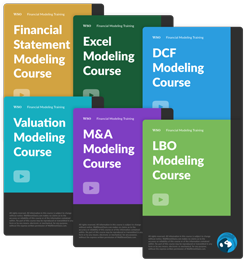LBO stands for Leveraged Buyout and refers to the purchase of a company while using mainly debt to finance the transaction. Leveraged Buyouts are usually done by private equity firms and rose to prominence in the 1980s. The company performing the LBO or takeover only has to provide a portion of the financing yet is able to make a large purchase through the use of debt, hence the name 'Leveraged'. During the 1980s - 1990s when LBOs were hot, debt could make up as much as 90% of the purchase of a business. However, now investors and private equity firms are a bit more risk adverse and therefore may use closer to 50% debt and 50% equity to purchase a business. The expectation with leveraged buyouts is that the return generated on the acquisition will more than outweigh the interest paid on the debt, hence making it a very good way to experience high returns whilst only risking a small amount of capital.
Leverage Buyout Definition
You can learn more about LBOs in the video below.
What Companies Make Good LBO Targets?
Considering that the buyer will put a large amount of debt on the company, it is critical that the company be stable and able to pay off its future debts otherwise it will likely default and go into bankruptcy. With that in mind, below are some types of companies that make good targets:
- Stable, strong cash flow business
- Company with low debt levels
- Non-cyclical businesses
- Companies with large economic moats
- Companies with good existing management teams
- Companies with a large asset base that can be used for collateral
- Distressed companies in good industries
Some private equity firms look to "turn around" troubled assets or may just look to buy an asset with the hopes of selling it for a better price in the future.
Free LBO Modeling Test (Email Form Below Video)
See if you're ready for the real deal. Video solution + modeling file included so you can get realistic practice. Just enter your email in the field below.
How Do PE Funds Increase the Value of the Target?
When a PE fund purchases a business, it either plans to hold the company and let it continue operating the same way or it may look to undergo operational improvements. These operational improvements may involve changing the management team of the business, selling off assets to unlock value, purchasing additional assets to make the core business more efficient, among a variety of different options. This is all done in the hopes of either increasing the profitability of the business or expanding the multiple that the business is valued at.
What Happens to the Debt in the LBO?
The PE firm will then either sell off parts or all of the target company or use its future cash flows to pay off the debt and then exit at a profit. Since the debt that is used to purchase the business is put on the books of the target company and not the PE firm (sponsor), when the company is sold any amount of debt that is paid down becomes equity. Once the target company is on stable footing, the sponsor may use the internal cash flows of the business to pay off the debt that was used in the buyout transaction. By doing this, they increase the return that they achieve when they sell the business either through an IPO or by selling the business to financial or strategic buyer. You can see a visual example below. 
After year 4, if we assume that the business has not been operationally improved and that the multiple assigned to the firm's EBITDA has not expanded, the business could be sold today for $100 million and the financial sponsor would receive $90 million dollars on their initial $40 million investment. In a span of 4 years, the company made $50 million dollars not including performance fees that they are being paid by their clients.
**To learn more about this concept and become a master at LBO modeling, you should check out our LBO Modeling Course. Learn more here.** 
Module 1: Introduction
Module 2: LBO The Big Picture
Module 3: Valuation and Transaction Assumptions
Module 4: Sources and Uses: The Theory
Module 5: Sources and Uses: Application to Nike Case
Module 6: P&L Projections & LBO Adjustments
Module 7: Debt Schedule
Module 8: Balance Sheet and Adjustments
Module 9: Taxes
Module 10: Exit, Returns, & Sensitivity Analysis
Bonus Module A) Purchase Price Accounting
Bonus Module B) Dividend Recap
Bonus Module C) Add-on Acquisition Build
Related Terms
- Acquisition
- Asset
- Bridge Loan
- Capital
- Collateral
- Covenant
- Discounted Cash Flow (DCF)
- Debt
- Debt
- Exit Multiple
- Free Cash Flow (FCF)
- Investment Banking Division (IBD)
- Internal Rate of Return (IRR)
- Junk Bond
- Leverage
- Management Buyout (MBO)
- Private Equity (PE)
- Takeover
- Valuation
.jpg?itok=DxumzaOP)

or Want to Sign up with your social account?